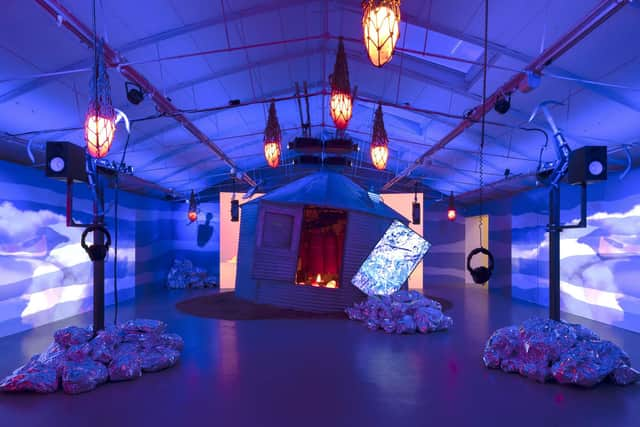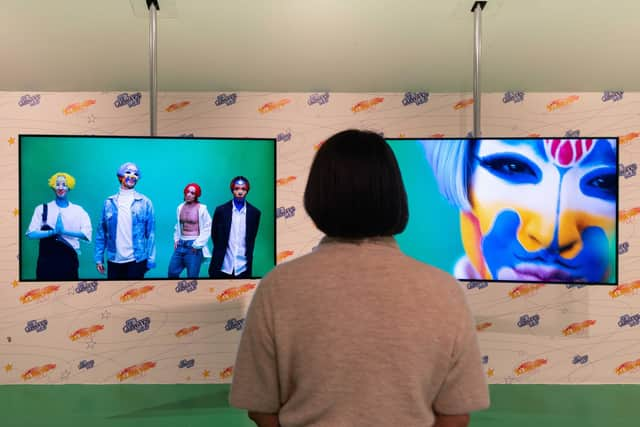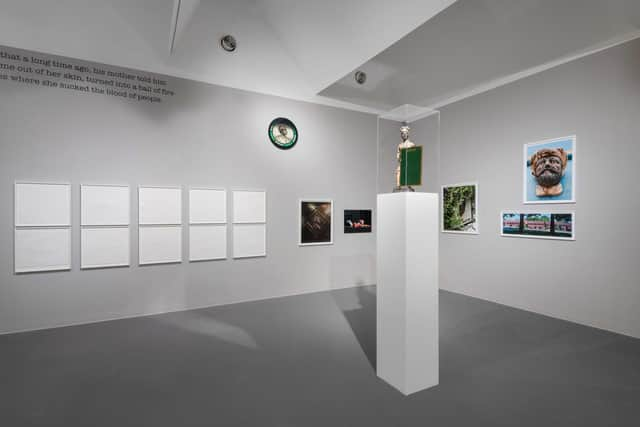Art review: The Turner Prize 2022, Tate Liverpool
The Turner Prize 2022, Tate Liverpool ***
The Turner Prize has had a few difficult years (haven’t we all). There was The Covid One (2020), in which ten bursaries took the place of a prize, The Collectives One (2021) in which all the shortlisted candidates were art collectives and, perhaps most intriguingly, The One Where All The Artists Clubbed Together And Shared The Prize (2019). This year, with a shortlist of four, an exhibition and (one hopes) a winner, there’s a sense of a return to business as usual.
That said, the four artists on the shortlist couldn’t be more different. Sin Wai Kin, 31, is one of the youngest artists ever shortlisted. Mixed race and non-binary, they make performative work exploring identity. Heather Phillipson is 44, a mid-career artist – and a poet and musician – who makes immersive installations. Ingrid Pollard and Veronica Ryan are both black women artists in their late sixties, but the similarities end there: their practices are as different as chalk and cheese.
Advertisement
Hide Ad

One of the aims of the Turner Prize is to promote contemporary art to a wider-than-usual audience, and the curators at Tate Liverpool have taken the unusual decision to put the interpretive material up front. Four well-made films introduce the work before we encounter it. Though this prevents us from engaging with the art purely on its own terms, it’s well-meaning, an example of the care which has gone into the show which also betrays an undercurrent of uncertainty. This is an anxious Turner Prize for an anxious world.
After the four films, it’s straight into a corridor lined with winking animal eyes, saturated in red light and throbbing with sound: Heather Phillipson’s Rupture No. 6: biting the blowtorched peach, a reworking of her installation made for Tate’s Duveen Galleries.
The corridor spits us out into a larger blue-lit space with films projected on the walls: a swan on a lake, a cloudscape, a setting sun turning into a peach. There are storm lanterns, ship’s anchors made into wind turbines, thunder, birdsong, the hum of machinery. The focus – if there is one – is on a lopsided silo made of corrugated metal. Salt crystal lamps shed an eerie light. Gas canisters clang together softly. There are giant bugs. The approach is cumulative: more is more.
Nothing quiet coheres, but there’s a sense of latent dread. “What’s the good of losing heart now?” says the voice on the audio. “We should have thought of it years ago.” Is it the wreckage of contemporary civilisation? A parallel universe, or this one, post climate catastrophe? The work resists fixed interpretation, although, in scale and sensory overoad, it can’t fail to make an impression.


Sin Wai Kin’s work champions fluidity too, for different reasons. The Toronto-born artist employs performance to explore – perhaps explode – questions of fixed identity, appearing in both male and female drag. Their strongest work is It’s Always You, in which Sin performs as each of the four members of a boy band: the clown, the heartthrob, and so on, all recognisable constructs. Everything is slick and hip and ironic: the videos, the posters, the life-size cardboard cut-outs, the hypnotic voice chanting: “Together we’re the one” and “I see my selves in you.”
A new 23-minute film, A Dream of Wholeness in Paris, references (as everyone seems to these days) Octavia Butler and Ursula K Le Guin, as well as the Taoist philosopher Chuang Tzu and the makeup styles of Chinese opera. It’s full of mirroring and doubling, male/female, East/West, inner/outer, but its particularity makes it difficult for the viewer to find a way in. The idea of the self being multiple isn’t new, and 23 minutes is a long time to watch a young person explaining it.
Advertisement
Hide AdVeronica Ryan’s work, which we arrive at straight after Phillipson’s cacophony, at first feels like an oasis of calm. Ryan’s pieces are mostly small in scale: long crocheted bags hold seed pods; fruit is cast in bronze. Sea shells are tied with coloured wool and placed in hand-made paper baskets. One might, perhaps, see references to climate change, global histories, sickness and healing (there is a neat stack of surgical cushions in one corner).
Everything is poised: there is, one feels, not a seed pod out of place. Objects, even mundane ones, are cradled, cushioned, imbued with significance. And, weirdly, one starts to feel on edge, as one might in a china shop, in the presence of too many fragile things.
Advertisement
Hide Ad

While it has a certain intriguing beauty, there is something off about the scale. It’s as if, by putting these small, intimate things together into a large environment, they have become distanced from the viewer. One finds oneself leaning and peering, while the things we are trying to see remain (like their meaning) a few steps too far away.
Ingrid Pollard, the last artist in the show, is the one whose work holds the least ambiguity. The major body of work here is Seventeen of Sixty-eight, a product of 25 years work in her research and photography-based practice looking into pubs in Britain with the name The Black Boy.
Thus she uncovers a strand of casual racism woven into the fabric of small-town and rural Britain, revealed here in grotesque pub signs and menu boards which have, presumably, become so familiar to those around them that they no longer see them for what they are. Her found objects and images lay this out, museum-style, calmly and without comment.
A further room includes several older works from 1991, and photographs of still earlier protest marches which were part of No Cover Up, her 2021 project at Glasgow Women’s Library. A new piece, Bow Down and Very Low – 123 takes its inspiration from a snatch of footage in a 1944 propaganda film which shows a young black girl making something between a bow and a curtsey. The movement is replicated and accentuated in a group of kinetic sculptures made from found objects. They’re awkward and creaky, but there’s no missing the message. A quote on the wall from Maya Angelou reads: “Now you understand why my head’s not bowed”.


In a way, this year’s Turner Prize lays bare the generation gap. Pollard’s work has plenty to say about race, about gay rights, about battles which had to be fought. The two younger artists have grown up in a world with fewer battles and, as a result, fewer fixed points of reference. Everything is fluid, everything is to play for, and it should be fun, but it isn’t, it’s full of anxiety.
This is a show full of contrasts: polished yet slightly disappointing; puzzling, sometimes frustrating, occasionally enlightening. In short, I’m happy to report, the Turner Prize is back to normal.
Until 19 March 2023